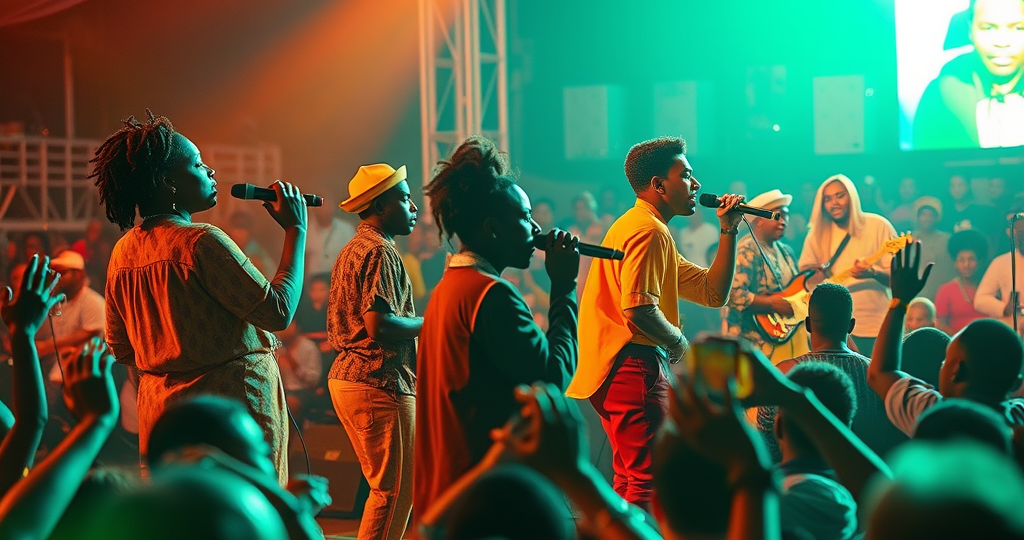I still remember the days when my Walkman was my best friend. Growing up in the late ’80s and early ’90s, I’d eagerly wait for the latest New Jack Swing, Soul, and R&B tracks from the US to hit the airwaves in Kenya. Artists like Bobby Brown, Whitney Houston, and Boyz II Men were the soundtrack of my teenage years, their voices crackling through my earphones as I walked the dusty streets of Nairobi.
Back then, Western music was king—our local airwaves were dominated by foreign hits, and for many of us, that was the pinnacle of cool. But fast-forward to 2025, and the story has flipped in the most beautiful way. My daughter, now a teenager herself, barely knows those American classics. Her playlist? It’s 90% to 95% Kenyan music, a phenomenon that Leonard Mudachi, a Kenyan music enthusiast, recently highlighted in a viral X post that caught my eye.
Mudachi’s post struck a chord with me, not just as a parent but as someone who’s watched Kenya’s music scene evolve over decades. He wrote about the emergence of the “Kenya First” music consumer—a generation of young Kenyans who proudly prioritize local artists over international ones. “While my teenage self was raised on a steady diet of US-based New Jack Swing, Soul, and R&B, my daughter’s playlist has a very heavy ‘Kenyan First’ bias,” he shared on April 9, 2025.
His words made me smile because I see the same thing in my own home. My daughter’s playlist is a vibrant mix of Sauti Sol, Nyashinski, and newer acts like Wakadinali, with their Gengetone beats that get her dancing around the living room. It’s a far cry from my cassette tapes, but it’s a change that fills me with pride.
Mudachi’s post didn’t just stop at observation. He pointed to a key player in this cultural shift: the Blankets and Wine festival, a 16-year-old event that has been instrumental in curating and developing Kenya’s live entertainment space. Founded by Muthoni Ndonga, known as Muthoni the Drummer Queen (or Muthoni DQ), this festival has become a cornerstone of the creative economy in Kenya, offering a platform for both emerging and established African artists.
In the 16th episode of Mudachi’s AfriCAN Do! Podcast, he sat down with Muthoni DQ to dive deeper into how Blankets and Wine has shaped this “Kenya First” movement and what it means for the future of the creative industry. The episode, available on YouTube and Spotify, is a must-listen for anyone interested in the intersection of music, culture, and economic opportunity in Africa.
A Journey Through Kenyan Music: From Benga to Gengetone
To understand how we got here, let’s take a step back. Kenyan music has always been a melting pot, shaped by the country’s 42 tribes and influences from across the globe. In the 1960s and ‘70s, Benga music emerged as Kenya’s first cohesive sound, blending traditional rhythms with modern instruments.
Bands like Them Mushrooms took it global with hits like “Jambo Bwana,” a song that even inspired Disney’s “Hakuna Matata” in The Lion King. Benga was our pride, a sound that resonated across East Africa and beyond, fusing styles like Taarab, Chakacha, and Reggae into something uniquely Kenyan.
But by the late ‘80s, things started to shift. Western hip-hop flooded the airwaves, and young Kenyans like me were hooked. I remember the first time I heard a rap song in Kiswahili—Ricky Oyaro’s “Renaissance” in the early ‘90s. It was a revelation.
Suddenly, we weren’t just listening to American rappers; we were making our own hip-hop in Sheng, the Kenyan slang that mixes English and Swahili. Shows like Mizizi on KBC gave aspiring rappers a platform, and artists like Jimmy Gathu became household names. It felt like a revolution, but it was still heavily influenced by the West.
The early 2000s brought another wave of change. Kenyan music started to fizzle out on mainstream platforms, overshadowed once again by Western hits. But beneath the surface, something was brewing. Groups like P-Unit, Sauti Sol, and Camp Mulla were quietly making their mark, ushering in what some call the “music group era.”
By the 2010s, these acts dominated the airwaves, blending Afro-pop, R&B, and hip-hop into a sound that was distinctly Kenyan. Sauti Sol’s “Sura Yako” became an anthem, played at every wedding and party I attended. Yet, towards the end of the decade, West African and South African music started to take over, with artists like Burna Boy and Black Coffee stealing the spotlight. Still, the Kenyan underground—dubbed “Nu Nairobi”—was taking shape, with genres like Gengetone giving voice to the youth in Nairobi’s estates.
Blankets and Wine: A Catalyst for Change
Enter Blankets and Wine, the festival that Mudachi credits with fueling the “Kenya First” movement. Launched in 2008 by Muthoni DQ, a singer, rapper, and drummer who plays the traditional ohangla drums, the festival started as a small side project. Muthoni, a powerhouse in her own right, turned it into a cultural juggernaut.
Since its inception, Blankets and Wine has hosted over 50 live shows, showcasing not just Kenyan talent but international stars as well. It’s expanded beyond Nairobi to Uganda and Rwanda, becoming a space where African culture is celebrated through music, art, and human connections.
I first heard about Blankets and Wine a few years ago when a friend invited me to one of their Nairobi events. I wasn’t sure what to expect—would it be a stuffy concert or a chaotic party? Instead, I found a vibrant, family-friendly festival where people spread out picnic blankets, enjoyed food from vendors like Onja Onja, and danced to live performances under the sun.
The energy was electric, with artists like Nyashinski and Fena Gitu commanding the stage while kids ran around and couples swayed to the music. It was a celebration of African creativity, and I left feeling a deep sense of pride in our culture.
Muthoni DQ’s vision for Blankets and Wine has always been clear: to promote and expose emerging African artists while creating a space for cultural expression. In a 2015 interview with Music In Africa, she shared how the festival evolved from a side hustle into a fully-fledged enterprise. “We decided two key things,” she said. “From 2014, we’d figure out the transition for the artist Muthoni DQ to move back into full-time music…
Then we said we were going back to the basics with Blankets and Wine, we’d put on a show for international artists as well as emerging artists.” That balance has been key to the festival’s success—it’s a platform where a young Kenyan artist can share the stage with a global star, proving that our talent can hold its own.
In 2025, Blankets and Wine is gearing up for its boldest season yet. According to their website, this year’s Nairobi events promise “electrifying live performances, irresistible flavors from Onja Onja, and nonstop energy from the DJ stage.” The hashtag #ItsAlwaysAGoodTime captures the vibe perfectly. I’m already marking my calendar—I can’t wait to see what they have in store.
The Digital Boom: Streaming Fuels the “Kenya First” Movement
While festivals like Blankets and Wine have played a huge role in this cultural shift, there’s another force at play: the rise of digital music streaming. A recent Statista report projected that Kenya’s music streaming market will reach US$21.63 million in 2024, with an annual growth rate of 7.46% through 2027, hitting US$26.84 million. That’s a lot of numbers, but what does it mean for someone like me or my daughter? It means access.
Platforms like Spotify and Apple Music have made it easier than ever to discover Kenyan artists, no matter where you are in the world.
I remember when getting new music meant waiting for a CD to arrive at the store or hoping the radio would play your favorite song. Now, my daughter can pull up a track by Bien or Karun with a few taps on her phone. Streaming has broken down barriers, giving Kenyan artists a global platform while allowing local fans to support them directly.
The Statista report notes that this growth is driven by factors like GDP per capita, consumer spending, and 4G coverage—basically, as more Kenyans get online and have disposable income, they’re spending it on music they love.
But it’s not just about the numbers. Streaming has changed how we connect with music on a personal level. My daughter doesn’t just listen to Kenyan artists; she follows them on social media, watches their YouTube interviews, and streams their live performances. She feels a connection to them because they’re singing about her world—her language, her struggles, her joys. That’s the power of the “Kenya First” movement: it’s not just about music; it’s about identity.
A Bright Future for Kenyan Music
As I reflect on Mudachi’s post and the journey of Kenyan music, I can’t help but feel optimistic. The “Kenya First” movement is more than a trend; it’s a cultural revolution. Festivals like Blankets and Wine and the rise of digital streaming have given Kenyan artists the tools to thrive, while young fans like my daughter are proving that there’s a massive appetite for local content. It’s a virtuous cycle—more demand leads to more investment in the creative economy, which leads to more opportunities for artists, which leads to even more demand.
Mudachi’s podcast episode with Muthoni DQ highlighted the economic potential of this shift. He noted that the “Kenya First” trend “highlights the magnitude of the opportunity for investment that the creative economy in the form of the live entertainment and festival space offers.” He’s right. With the music streaming market growing and events like Blankets and Wine drawing bigger crowds, there’s never been a better time to invest in Kenyan talent.
For me, the most exciting part is what this means for the next generation. My daughter and her friends aren’t just passive consumers; they’re active participants in a cultural renaissance. They’re the ones streaming, sharing, and showing up to support Kenyan artists. They’re the ones ensuring that our music, our stories, and our voices are heard. And as a parent, there’s nothing more joyous than witnessing that.
So here’s to the “Kenya First” movement, to Blankets and Wine, and to the artists who are putting Kenyan music on the map. May this revolution continue to grow, one beat at a time.

